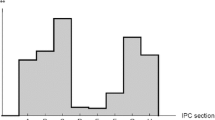Abstract
With globalization, firms acquire locally unavailable inputs from and collaborate in innovation with firms in other regions. We contend that, depending on the collaboration distances feasible and spatial layout of regions, a core-periphery structure of regions emerges, in which core regions produce more advanced and complex products. We develop a spatial agent-based model of (supraregional) firm collaboration in production and innovation to study technological progress. We find that when collaboration is possible over greater distances, agents produce more advanced and more complex products. Moreover, we find that, in general, the core-periphery structure indeed emerges. However, for some layouts, the core-periphery structure vanishes almost immediately, while for others first becomes stronger, peaks and then vanishes with an increase in collaboration distance. Moreover, we find that the properties of the technology structure play a prominent mediating role, e.g. the effect of supraregional collaboration on technological progress may be strong for some and relatively weak for other structures.
This work was realized with financial support of the Dutch science foundation NWO, grant 458-03-112, and the DACH research program Innovation Networks for Regional Development partly funded by the German science foundation DFG, grant PY 70/8-1, and partly funded by the Austrian science foundation FWF, grant I 886-G11.
Access this chapter
Tax calculation will be finalised at checkout
Purchases are for personal use only
Preview
Unable to display preview. Download preview PDF.
Similar content being viewed by others
References
Rallet, A., Torre, A.: Is geographical proximity necessary in the innovation networks in the era of global economy? Geo Journal 49(4), 373–380 (1999)
Bathelt, H., Malmberg, A., Maskell, P.: Clusters and knowledge: local buzz, global pipelines and the process of knowledge creation. Progress in Human Geography 28(1), 31–56 (2004)
White, R., Engelen, G.: Cellular automata as the basis of integrated dynamic regional modelling. Environment and Planning. B 24, 235–246 (1997)
Caruso, G., Peeters, D., Cavailhes, J., Rounsevell, M.: Spatial configurations in a periurban city. A cellular automata-based microeconomic model. Regional Science and Urban Economics 37, 542–567 (2007)
Gilbert, N., Pyka, A., Ahrweiler, P.: Innovation networks: A simulation approach. Journal of Artificial Societies and Social Simulation 4(3) (2001), http://www.soc.surrey.ac.uk/JASSS/4/3/8.html
Morone, P., Taylor, R.: Knowledge diffusion and innovation: Modelling complex entrepreneurial behaviours. Edward Elgar Publishing (2010)
Vermeulen, B., Pyka, A.: Technological progress and effects of (supra)regional innovation and production collaboration. An agent-based model simulation study. In: Proceedings of IEEE Conference on Computational Intelligence for Financial Engineering & Economics, CIFEr (2014)
Basalla, G.: The Evolution of Technology. Cambridge University Press (1988)
Vermeulen, B., Pyka, A.: The effects of supraregional innovation and production collaboration on technology development in a multiregional world. A spatial agent-based model study. Forschungszentrum Innovation und Dienstleistung, Discussion Paper (2014)
Author information
Authors and Affiliations
Editor information
Editors and Affiliations
Rights and permissions
Copyright information
© 2014 Springer International Publishing Switzerland
About this paper
Cite this paper
Vermeulen, B., Pyka, A. (2014). The Effects of Supraregional Innovation and Production Collaboration on Technology Development in a Multiregional World: A Spatial Agent-Based Model Study. In: Wąs, J., Sirakoulis, G.C., Bandini, S. (eds) Cellular Automata. ACRI 2014. Lecture Notes in Computer Science, vol 8751. Springer, Cham. https://doi.org/10.1007/978-3-319-11520-7_74
Download citation
DOI: https://doi.org/10.1007/978-3-319-11520-7_74
Publisher Name: Springer, Cham
Print ISBN: 978-3-319-11519-1
Online ISBN: 978-3-319-11520-7
eBook Packages: Computer ScienceComputer Science (R0)



